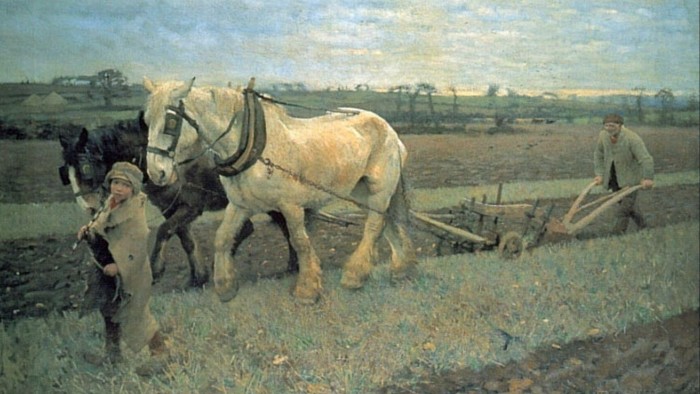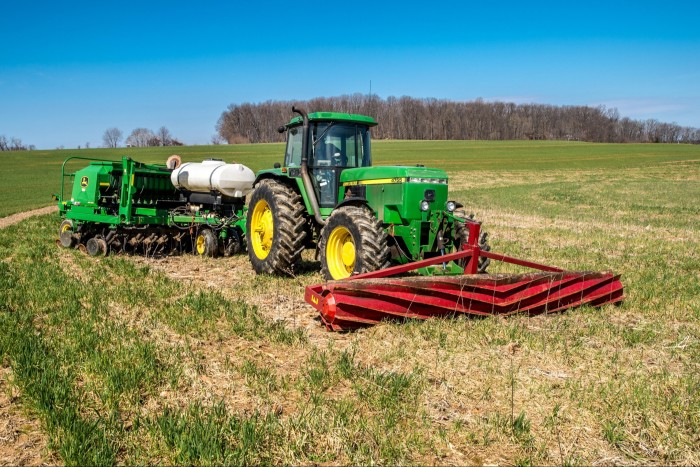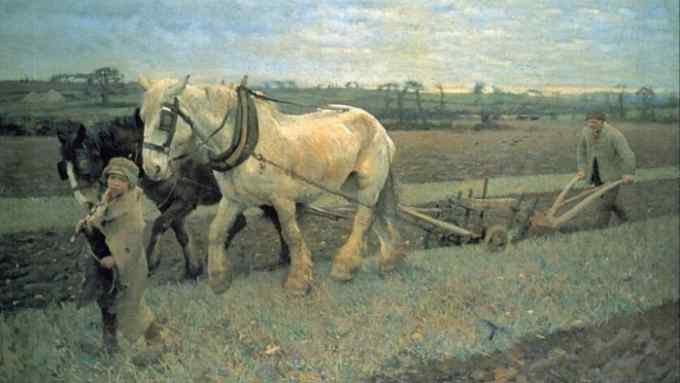Will no-till farming put paid to the plough?

Roula Khalaf, Editor of the FT, selects her favourite stories in this weekly newsletter.
The ploughman turning over the soil, burying weeds and presenting a fertile seedbed for next year’s crop, has been one of agriculture’s most powerful images for centuries. The plough, itself, developed from a simple hand-wielded tool into a powerful implement drawn by animals and then tractors, pulling a metal “mouldboard” to invert the earth as it is cut.
Now, however, farmers are coming under pressure to plough less, for the sake of soil health and to reduce their climate impact. The emphasis is on minimising disturbance of the surface, if possible, through “no-till” or “min-till” methods that drill or plant seeds directly, without aggressive tilling.
Jonathan Storkey, a soil scientist at Rothamsted Research in the UK, lists the many advantages claimed by the “regenerative agriculture movement” for minimal tilling. “A big part is less soil disturbance,” he says. “In dryland agriculture, erosion and drought pressure are reduced. In temperate regions, the benefits include improved soil health, increased soil carbon and microbial function, and less greenhouse gas emissions because you don’t use diesel for ploughing.”
But there are balancing trade-offs, Storkey adds. “Primary among those is your limited opportunities for controlling weeds. One of the big contributions of ploughing to agriculture is to bury weeds and control weed populations,” he says. “A build-up of pernicious weeds, such as grasses, is commonly seen in reduced tillage systems.”
A solution to the weed problem frequently adopted by non-organic farmers is to spray the field with a broad-spectrum herbicide such as glyphosate, says Storkey. But that option is not open to organic farmers, who avoid applying agrochemicals to their crops.
Many organic farmers, therefore, tend to be friends of the plough. “I have long supported ploughing,” says Mark Measures, a leading UK expert on organic agriculture. “We need some form of soil cultivation because we don’t have no-till systems that work reliably, but we focus on avoiding ploughing much deeper than four to six inches [10 to 15cm], so as to avoid damage to life in the soil.”
Shallow ploughing and “non-inversion” tillage, which cuts into the soil without turning it over, sustain essential mycorrhizal fungi and worms below ground more successfully than zero-till agriculture that depends on dosing fields with biome-damaging agrochemicals, Measures argues. Soil fertility can be enhanced through crop rotation and the application of compost or manure.
“The process of cultivation is not just about soil structure and weed control,” he argues. “It’s also about the whole process of soil carbon oxidation, bringing air to the soil and making nutrients available to the crop.”
Patrick Holden, founder of the Sustainable Food Trust and another prominent organic farmer, is also a firm defender of ploughing. “The plough has become a scapegoat for the umbilical dependence of agriculture on Roundup [a glyphosate-based herbicide],” he says. “In most parts of the world, including the UK, it is impossible to establish annual crops without breaking the soil or using herbicides.”
“Roller crimper” machines, which crush and cut up weeds and other plants growing on the field before sowing, may help. So may intensive grazing of a cover crop with sheep. However, Holden believes most soils will still require ploughing from time to time.

With the increasing pressure on agriculture to cut greenhouse gas emissions, researchers are trying to work out the effects of alternative cultivation methods on the amount of carbon sequestered in the soil.
The results are not as clear-cut as advocates of min-till sometimes suggest, says Storkey. “There is some evidence that you can increase total carbon stocks [in the soil] in reduced tillage systems, but it comes with caveats and it can be overstated.”
Measures agrees. “Some of the claims made for substantial, permanent increases in soil carbon are not plausible for various reasons, including inadequate monitoring,” he says.
No one is more wedded to the joy of ploughing than John Hill, three times World Ploughing Champion and a director of the UK Society of Ploughmen. On his family’s farm at Hoylandswaine in South Yorkshire, “we do some direct drilling — and that’s OK in some circumstances on some soils — but predominantly we use the plough,” says Hill.
He also points out that some farming neighbours who have adopted min-till more wholeheartedly than his family still keep their ploughs — just in case the weeds become too rampant.
Farmers may need patience in moving away from ploughing, says Storkey, as there can be a reduction in yields for the first five or six years of reduced tillage, owing to poorer soil structure.
“You might get capping or compaction of the soil at the top, which makes it more difficult for crops to establish and roots to penetrate,” he explains. “It takes several years for the soil biology and worm populations to build up to the extent that they can substitute for mechanical cultivation in terms of improved soil structure and porosity.”
Hill still sees a future for the plough at the heart of farming, far beyond the nostalgia-fuelled agricultural sport that he enjoys. “I’m not advocating ploughing for everyone everywhere, but farmers have used it successfully for hundreds of years to get rid of all the rubbish under the soil,” he says. “I would be very surprised if ploughing is not still going on in 100 years’ time.”

Comments